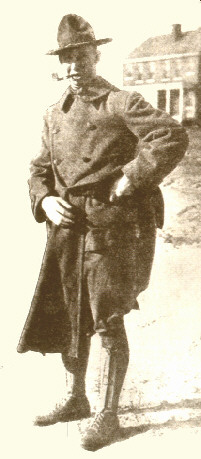Eddie Grant (baseball)
| Eddie Grant | |
|---|---|
 | |
| Infielder | |
| Born: May 21, 1883 Franklin, Massachusetts | |
| Died: October 5, 1918 (aged 35) Argonne Forest, France | |
Batted: Left Threw: Right | |
| debut | |
| August 4, 1905, for the Cleveland Naps | |
| Last appearance | |
| October 6, 1915, for the New York Giants | |
| Career statistics | |
| Batting average | .249 |
| Hits | 844 |
| RBI | 277 |
| Stolen bases | 153 |
| Teams | |
Edward Leslie Grant (May 21, 1883 – October 5, 1918),[1] was an American third baseman in Major League Baseball who became one of the few major leaguers who were killed in World War I.[2]
Biography

He was born on May 21, 1883 in Franklin, Massachusetts.
After completing high school in 1901, Grant attended Dean Academy (now Dean College) in Franklin for a year before enrolling at Harvard University (earning him the nickname "Harvard Eddie").[3] While at Harvard, Grant was a member of the freshman basketball and baseball teams. He played varsity basketball for the Crimson during his sophomore year in 1903, and was set to play varsity baseball the following spring until he was declared ineligible for playing in a professional independent baseball league the previous summer.[3] He graduated from Harvard University with an undergraduate degree in 1905 and a law degree in 1909.
Grant entered the majors with the Cleveland Indians at the very end of the 1905 season as an emergency replacement for an ailing Nap Lajoie.[3] He played in the minor leagues in 1906, but returned to the majors with the Philadelphia Phillies in 1907, and was the Phillies' starting third baseman from 1908–1910. Grant batted leadoff for the Phillies, but was known more for his fielding and base stealing than his bat. His best year was 1910, when he batted .268, drove in 67 runs, and stole 25 bases.[1]
Traded to the Cincinnati Reds in 1911, he batted just .223, his last year as a starter. Grant was traded again to the New York Giants in the middle of the 1913 season, where he finished his career as a utility infielder. Grant appeared in two games of the 1913 World Series, once as a pinch runner and once as a pinch hitter.[3] He retired after the 1915 season. His lifetime batting average was .249.[1]
Perhaps because of his Harvard background, Grant refused to call for a fly ball by yelling, "I got it!" Instead, he would only say the grammatically correct, "I have it!"[4]
Post-career
Upon his retirement from baseball, he opened a law practice in Boston.[3]
Grant was one of the first men to enlist when the United States entered World War I in April 1917, and he served as a Captain in the 77th Infantry Division. During the fierce battle of the Meuse-Argonne Offensive, all of Grant's superior officers were killed or wounded, and he took command of his troops on a four-day search for the "Lost Battalion." During the search, an exploding shell killed Grant on October 5, 1918.[2][5] He was the first Major League Baseball player killed in action in World War I.[6] He was buried at the Meuse-Argonne American Cemetery in Lorraine, France.[7]
Legacy
On Memorial Day, May 29, 1921, representatives from the armed forces, baseball, and the sisters of Grant unveiled a monument in center field of the Polo Grounds to his memory. During the celebration at the end of the last Giants' game in 1957, someone pried the plaque from its monument.[2] It was missing for over 40 years until it was claimed re-discovered in a Ho-Ho-Kus, New Jersey home that had been owned by a New York City police officer.[8] However, the photo shown of the supposed plaque on the Internet does not look like the missing plaque from the Polo Grounds, which has now been replicated at the San Francisco Giants current ballpark as of 2006.
Grant is also memorialized with the Edward L. Grant Highway in The Bronx, New York and by Grant Field at Dean College.[3]
See also
- List of baseball players who died during their careers
- List of Major League Baseball leaders in career stolen bases
References
- ^ a b c "Eddie Grant Career Stats". baseball-reference.com. Retrieved 2007-11-20.
- ^ a b c "The Great War Society: This Months Great Veteran". worldwar1.com. Retrieved 2007-11-20.
- ^ a b c d e f Simon, Tom, ed. (2004). Deadball Stars of the National League. Deadball Era Committee of the Society of American Baseball Research (1st ed.). Dulles, Virginia, United States of America: Brasseys. p. 367. ISBN 1-57488-860-9.
- ^ http://www.baseballreliquary.org/EddieGrantPlaque.htm
- ^ "Captain 'Eddie' Grant Killed In France. Ex-Third Baseman of the Giants Slain in Attempt to Rescue 'Lost Battalion'". Associated Press in New York Times. October 22, 1918. Retrieved 2009-07-24.
Captain Edward Grant, former third baseman of the New York National League Club, and attached...
{{cite news}}: Cite has empty unknown parameter:|coauthors=(help) - ^ Crazy ’08: How a cast of Cranks, Rogues, Boneheads and Magnates created the Greatest Year in Baseball History, p. 111, by Cait Murphy, Smithsonian Books, a Division of Harper Collins, 2007, ISBN 978-0-06-088937-1
- ^ Edward Leslie "Harvard Eddie" Grant at Find a Grave
- ^ "Baseballogy 101". baseballreliquary.com. Retrieved 2007-11-20.
External links
- Career statistics and player information from Baseball Reference, or Baseball Reference (Minors)
- Eddie Grant at Flickr
- 1883 births
- 1918 deaths
- People from Franklin, Massachusetts
- Harvard Crimson men's basketball players
- Harvard Law School alumni
- Cleveland Naps players
- Philadelphia Phillies players
- Cincinnati Reds players
- New York Giants (NL) players
- Major League Baseball third basemen
- Baseball players from Massachusetts
- American military personnel killed in World War I
- Jersey City Skeeters players
- United States Army officers
- Burials at Meuse-Argonne American Cemetery and Memorial
